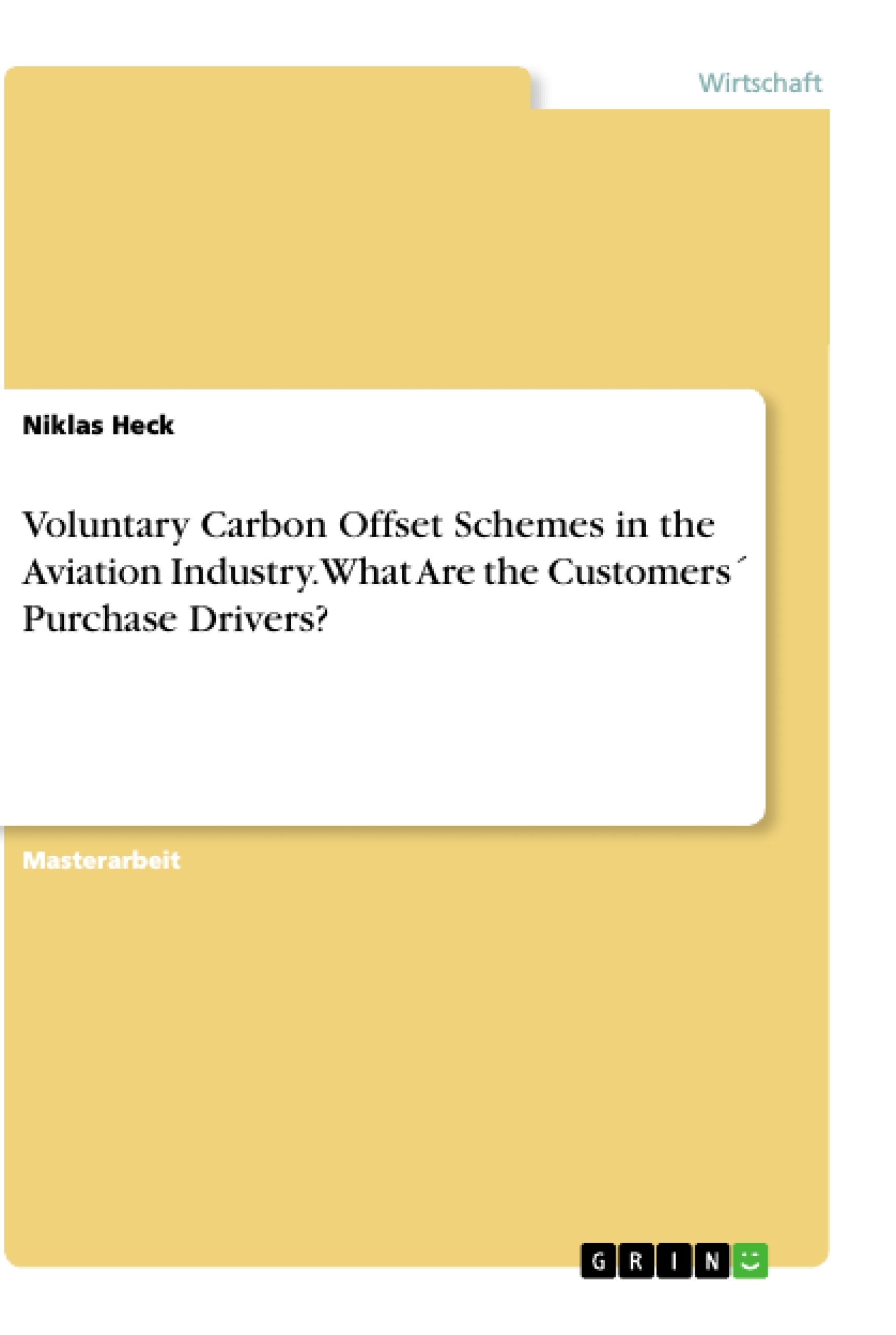Within the scope of this work, it was investigated which properties of such a voluntary carbon offset product contribute significantly to the air travellers’ willingness to purchase. For this purpose a Choice-Based Conjoint Analysis was used.
As the issue of greenhouse gases and their origins becomes more and more central to the economy, actors in the aviation industry also need to increasingly reflect on their business models and adapt them where necessary. In addition to the so-called "compliance markets", through which the aviation industry is mainly influenced by regulations, there is also the possibility of voluntary offsetting the CO2 emissions caused by flights. This option is transferred to the end consumer in the form of "voluntary carbon offsets". Previous research indicates above all the low level of awareness among air travellers on the subject of voluntary carbon offsets.
After an introduction to the theoretical framework of pro-environmental behaviour of people and the principle of VCO, the methodology part provides an overview of conjoint analysis. This overview enables the selection of a suitable analysis with regard to practical implementation. Based on the theoretical part, the hypotheses are derived. The empirical part of the work is intended to answer the research questions. For this purpose, the appropriate method is brought to practical implementation through a survey questionnaire and the subsequent statistical analysis. In the discussion and final chapter of the thesis the results are interpreted to discuss possible explanations for why certain criteria are more important than others. In addition, the preferred levels within the attributes are analysed, which sheds more light on the needs of airline customers when making VCO purchases. The results of the study are valuable for business practitioners and can be used for a better understanding of how VCO schemes need to be offered to customers in order to maximize their WTO. They also make a scientific contribution to the voluntary carbon offset behaviour of air travellers and their evaluation of various product characteristics.
Inhaltsverzeichnis
- Abstract...
- List of Figures............
- List of Tables…..........\li>
- Abbreviations.
- 1. Introduction..........\n
- 1.1 Voluntary Carbon Offset and the Need for it.
- 1.2 Research Goal and Research Question.......
- 1.3 Structure of the Thesis....
- 2. From Theory to Hypotheses.\n
- 2.1 Rising CO2 Emissions and Mitigation Methods in the Airline Industry...\n
- 2.1.1 Aviation Industry and Greenhouse Gas Emissions on the Upswing..
- 2.1.2 Offset Markets.
- 2.2 Behavioural Reasons For Voluntary Carbon Offset Payments of Air Travellers..\n
- 2.2.2 Pro-environmental Behaviour and Feelings of Guilt
- 2.2.3 The Influence of Trust on The Willingness to Offset
- 2.2.4 Frequent Flyers Miles as Method of Payment...
- 2.1 Rising CO2 Emissions and Mitigation Methods in the Airline Industry...\n
- 3. Methodology\n
- 3.1 Research Method..
- 3.2 Format of Data Collection.
- 3.3 Survey Design...
- 3.4 Testing the Experimental Design.
- 4. Empirical Analysis........\n
- 4.1 Sample Description.
- 4.2 Individual Criteria Utilities..\n
- 4.2.1. Relative Impact of Each Attribute.
- 4.2.2. Interaction.
- 4.2.3. Hierarchical Bayesian Estimates.
- 4.2.4. Importance Scores
- 4.2.5. Market Simulation Results.
- 4.2.6. Short-haul and Long-haul Comparison.
- 4.3 Explorative Analysis........
- 5. Discussion and Limitations of the Research\n
- 5.1 Discussion of the Findings....
- 5.2 Limitations and Future Research..
Zielsetzung und Themenschwerpunkte
Diese Masterarbeit befasst sich mit den Kaufmotiven für freiwillige CO2-Kompensationsmodelle in der Luftfahrtindustrie. Sie zielt darauf ab, die Eigenschaften eines solchen Produkts zu identifizieren, die einen signifikanten Einfluss auf die Kaufbereitschaft von Flugreisenden haben. Die Arbeit untersucht dieses Thema mithilfe einer Choice-Based Conjoint Analysis.
- Voluntary Carbon Offset als Instrument zur Reduzierung von CO2-Emissionen in der Luftfahrt.
- Faktoren, die die Kaufbereitschaft von Flugreisenden für Voluntary Carbon Offsets beeinflussen.
- Anwendung der Choice-Based Conjoint Analysis zur Untersuchung von Präferenzen und Kaufentscheidungen.
- Bewertung des Einflusses von Merkmalen des Produkts auf die Kaufbereitschaft.
- Bedeutung von Vertrauen und Transparenz im Kontext von Voluntary Carbon Offsets.
Zusammenfassung der Kapitel
Das erste Kapitel führt in die Thematik der freiwilligen CO2-Kompensation und deren Bedeutung für die Luftfahrtindustrie ein. Es werden Forschungsziele und Fragestellungen definiert sowie die Struktur der Arbeit erläutert. Kapitel 2 beleuchtet die theoretischen Grundlagen, insbesondere die steigenden CO2-Emissionen in der Luftfahrt und die Möglichkeiten zur Emissionsminderung. Weiterhin werden Verhaltensmotive von Flugreisenden hinsichtlich freiwilliger CO2-Kompensation, wie Pro-Umwelt-Verhalten und Vertrauen, untersucht. Kapitel 3 beschreibt die Forschungsmethodik, die in dieser Arbeit eingesetzt wird, inklusive der Choice-Based Conjoint Analysis. Es werden die Datenerhebung, die Gestaltung des Fragebogens und die Testung des Studiendesigns erläutert. Kapitel 4 analysiert die empirischen Ergebnisse der durchgeführten Studie. Die Ergebnisse werden hinsichtlich der Relevanz einzelner Produktmerkmale für die Kaufbereitschaft interpretiert. Die Ergebnisse werden diskutiert und die Grenzen der Forschung werden im fünften Kapitel dargestellt.
Schlüsselwörter
Die Arbeit behandelt die Themen Freiwilliger CO2-Ausgleich, Luftfahrtindustrie, Choice-Based Conjoint Analyse, Kaufbereitschaft, Umweltbewusstsein und Vertrauen.
- Quote paper
- Niklas Heck (Author), 2020, Voluntary Carbon Offset Schemes in the Aviation Industry. What Are the Customers´ Purchase Drivers?, Munich, GRIN Verlag, https://www.grin.com/document/962164



